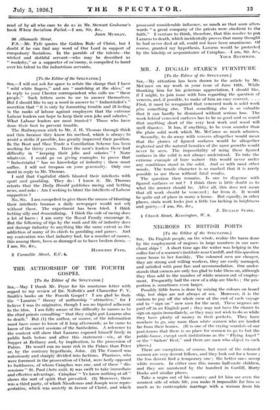MR. J. DUGALD STARK'S FURNITURE
[To the Editor of the SPECTATOR.]
SIR,—My attention has been drawn to the article by Mr.
McCance on my work in your issue of June 19th. While thanking him for his generous appreciation, I should like, if I might, to join issue with him regarding the question of veneers, and, if possible, to make of him an easy convert. . . . First, it must be recognized that veneered work is solid work plus something else. That something else is so valuable that it can hardly be dismissed without serious loss. The work behind veneered surfaces has to be so good and so sound that anything short of the very best work and wood will spell disaster. It has, if anything, to be even sounder than the plain solid work which Mr. McCance so much admires.
Secondly, to do away with veneers altogether would mean that the glories of figured surfaces would be altogether neglected and the natural beauties of the rarer growths would never be seen. The impossibility of using these figured surfaces in the solid is not always understood. To take the extreme example of burr walnut—this would never under any conditions stand in the solid. And so with most other woods. The tensile character is so marked that it is rarely possible to use them without fatal results.
The question then remains. Is one to dispense with figured surfaces or not ? I think there is little doubt as to what the answer should be. After all, this does not mean that all work should be veneered ; far from it. It would be quite out of place in many a home. But equally, in other places, stain work looks just. a little too lacking in brightness and gaiety.—I am, Sir, &c.,
1 Church Street, Kensington, H. S.
J. DUCALD STARK.










































 Previous page
Previous page